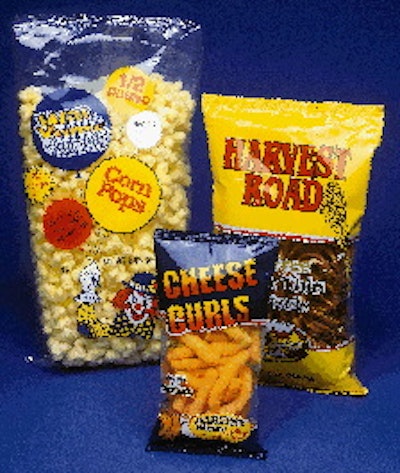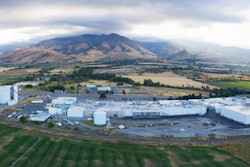No company wants to see its main manufacturing plant leveled by a devastating fire. But when Pretzels, Inc. of Bluffton, IN, went up in flames on Christmas Eve, 1997, the disaster came with a silver lining.
"It enabled us to look back at what we'd done piecemeal over nearly 20 years and redo it all with what we know today," says senior vice president and general manager Tom Anderson.
The privately held snack maker didn't waste any time, either. By July, just seven months after the fire, both extruded snack products and pretzels were in production in a newly built facility on the same site. And by August, "Everything was up and running," says Anderson.
Included in that "everything" are 23 combination scales mounted over 23 vertical form/fill/seal baggers. The Ishida scales are from Heat and Control (Hayward, CA), the Ultima baggers from Hayssen (Duncan, SC). Each bagger is equipped with an AK-15 hot stamp imprinter from Norwood (Downers Grove, IL). Bag weights range from 3/4-oz to 3 lb.
Chief among the benefits of the new layout is the consolidation of all packaging equipment in one room. In the pre-fire plant, packaging was done in three different plant locations. It wasn't ideally configured, either. Pretzel packaging, for example, was in the center of the plant, with no room around the existing machines to allow for expansion. In the new plant, only five of the 23 scale/bagger combinations are still located outside of the new packaging room, and they'll join their mates as soon as some older ovens are replaced by new ones in the new oven area. "Once we have all the packaging equipment in one large room," says Anderson, "we'll add another 30ꯠ square feet with some dock doors, and then all packaging materials will enter the plant through those dock doors. From east to west, it will be a smooth flow of packaging materials to packaging machines to palletizing to the finished goods warehouse."
Assisting in designing this smooth flow, adds Anderson, was contractor/engineer Shambaugh & Son (Fort Wayne, IN). That company provided the plant layout shown on page 38.
Horizontal-motion conveyors
Product flow into the packaging room is also improved through the use of FastBack(TM) horizontal-motion conveyors. Supplied by Heat and Control, these conveyors transport product to whichever bagging machines are appropriate. Each FastBack module consists of a stationary drive and a stainless-steel pan measuring 2' across and as much as 25' in length. Housing a cylindrical gear motor, the stationary drive unit causes the pan to stroke forward slowly and then back quickly. This causes product to advance on the forward stroke but not be drawn back by the reverse stroke. Says Anderson of the conveyor's back stroke, "I like to think of it as ripping the tablecloth out from under the dishes without disturbing any dishes.
"Vibratory conveyors shake too much of the salt off the pretzels," he continues. "Also, they're typically belt conveyors of some kind, and compared to stainless-steel pans, belts are so much more difficult to clean. Besides, fabric belts wear over time, and the stainless steel doesn't."
Pretzels' new plant uses 80 of these FastBack modules, both distribution conveyors and cross feeders, all linked together as shown in the floor plan on page 38. In the section marked A, for example, two FastBack distribution conveyors run side by side from west to east. The northern one might carry cheese curls and the southern one artificial popcorn.
Below and perpendicular to these distribution conveyors are the FastBack cross feeders. Each delivers product from the distribution conveyors to the combination scales. If scales one, two and three are pegged for cheese curls, gates in the northern distribution conveyor will open at cross-feed conveyor one, two and three to drop the product on demand. Gates one, two and three in the southern distribution conveyor will remain closed so that the artificial popcorn will be carried forward to gates that drop the popcorn into cross-feed conveyors four and five.
One key benefit the company now enjoys that it didn't have before the fire is adequate surge capacity. This is important when there are stoppages at the baggers, due to either mechanical problems or because packaging film has to be replaced. When a stoppage occurs, the last thing the company wants to do is slow down or stop the extruders or ovens because that jeopardizes product consistency and quality.
In the new plant, the company incorporated a FastBack surge hopper on each of the extruded snack lines and one each on pretzel ovens nine and 10. If the baggers can't accept the volume of product being conveyed toward them, product begins to back up in the distribution conveyors. When product in a conveyor accumulates to a certain level, photocells signal the system's programmable logic controller to shut down that conveyor module. This process continues upstream, from one module to the next, all the way to the processing room. At that point, the surge hopper, located in the processing room at the oven discharge, kicks in.
"When the problem clears, the whole path swings back into action sequentially in the opposite order as it shut itself down," says Anderson.
The cluster of baggers marked C have a different kind of surge capacity, says Anderson. "A loop system of conveyors provides surge capability," says Anderson. When a bagger goes down, and the next baggers in line can't accept more pretzels, the pretzels will be conveyed past those machines and enter a return loop to be bagged the next time around.
Pretzel capacity
Baggers devoted to extruded snacks are outnumbered in the packaging room by baggers that package pretzels. As the floor plan diagram shows, four ovens feed the 13 pretzel baggers now running. In each case, the pretzels are conveyed from the oven room to the packaging room in a tube conveyor from Speed King (Dodge City, KS). Four more pretzel ovens and 12 more pretzel baggers are penciled in for installation at a future date.
According to maintenance manager Steve Kellogg, the Hayssen Ultima bagging machines in the new plant are similar to those lost in the fire. But the new equipment, he says, has been upgraded.
"The key advantage is stepper motors replacing electric motors and gear boxes and air cylinders in certain areas," says Kellogg. "They make it easier to track the film and change it when necessary."
The most specialized scale/bagger pairs are the four in the section marked C. They receive only pretzel rods, either 7" or 9" long. On these machines, a specially designed vertical timing hopper beneath the scale halts the drop of the pretzels four times before they actually drop into the bag. This incremental drop breaks the fall of the pretzels, thus minimizing breakage. One of two ovens, number five or number six, can feed this cluster of baggers.
The third and final group of baggers (B in the diagram) receives pretzels from ovens 5, 9 or 10.
What quickly becomes clear is the flexibility of the layout. Delivery of the product to packaging is governed by two independent PLCs, one for extruded snacks and one for pretzels. Both PLCs are from Allen-Bradley (Milwaukee, WI), Model SLC504 that use RS Logics 500 software, also from Allen-Bradley. To redirect an oven's output from one bagger to another, the line supervisor enters the necessary information at an Allen-Bradley 1400E Panel View operator interface panel. Its Panel Builder software delivers the necessary information to the PLC so that the supervisor's wishes can be carried out. In other words, gates open and close and product is redirected according to data the line supervisor enters at the operator interface panel.
Although the two PLCs are independent of each other, they are linked by a communications network, again from Allen-Bradley, called Highway Plus. This makes it possible for the company to implement a Supervisory Control And Data Acquisition (SCADA) system at a future date. Such systems automatically collect data from equipment on the plant floor, and the data can be used to understand where improvements can be made and efficiencies gained.
Flexibility is a key
The flexibility provided by the PLC controls system and the modular conveyors is crucial for a snack maker like Pretzels, Inc. because its business is primarily private-label co-packing. As Anderson puts it, "We run a lot of sizes and a lot of labels. It's whatever the customer wants."
Ever-changing as its business is, Pretzels, Inc. is not a good candidate for automated case packing.
"It just doesn't fit us," says Anderson. "I've seen some good units out there, but they seem better suited to more dedicated runs. It's our business to be undedicated."
Case erecting and packing is currently done by hand, with one operator assigned to each bagger. Each operator gets an assist from an automated collator supplied by Fallas Automation (Waco, TX). As bags drop from a vf/f/s machine, they're flattened by a short length of vibratory belt and then quickly transferred to a conveyor belt that runs upward at a 45° angle.
This belt delivers bags to the Fallas Model RW collator. Each bag moves around a rotary wheel whose stacking fingers cause bags to leave the wheel standing upright on a packoff conveyor. As soon as the appropriate number of bags is available to the packer, who has already erected a corrugated shipper, he or she picks up the group from the collator and loads them into the shipping case.
A Zebra Technologies (Vernon Hills, IL) thermal-transfer printer prints a pressure-sensitive case label with contents, code date, customer name and bar code. The packer applies this label, tapes the case closed and then puts the case on a conveyor that leads to palletizing.
Depending on how many baggers are in operation, as many as 23 packers may be putting case-packed product on the takeaway conveyor. Twists, sticks, logs, minis, popcorn, cheese curls--they all enter the palletizing area on the same powered roller conveyor. Operators then palletize them there. Just ahead of palletizing, cases pass a metal detector from Fortress Technology (Toronto, Ontario, Canada) that rejects any case containing metal.
Impressive as Pretzels Inc.'s new plant now looks, it will only get bigger and better in the near future. As the floor plan shows, four more 130'-long ovens and another 16 or so scale/bagger systems are already planned. Automatic case erectors are in the works, too, which would spare the packers that onerous task and potentially bring an increase in packaging speeds.
"Our machines can easily run 75 bags/min," says Anderson. "But one person has a hard time case packing more than 45 or 50. So rather than run baggers at 75 per minute and use two people to box them at a net output of 37.5 bags per minute, we slow our baggers a bit to where one bagger can work at a steady clip of 45 bags per minute. If we relieve our packers of the task of erecting cases, we may be able to speed things up some."
Precisely when that happens is not clear yet. What is clear is that when it happens, there will be sufficient space to accommodate it.
"We designed the plant thinking not only about where we'd be when construction ended, but with a view to where we'll be five or 10 years down the road," says Anderson.






















